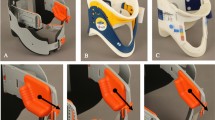Abstract
Frequently there are disasters all over the world—fires, earthquakes, or even some unexpected shocking catastrophes. Hence people injured, or even died. Lifesaving actions begin with the initiation of the chain of survival. With every minute that passes without medical action being taken, the probability of being able to save the patients life decreases by ten percent. After 10 min there is normally no chance of resuscitation being successful. First aid is emergency treatment given before regular medical aid can be obtained. And it is a concept of first hands-on measures performed in a medical emergency by laypersons. The major aim of this study is to develop an easy—feasible cervical collar, for facilitating and accelerating implementation of first aid especially in case of collective injuries. The developed device is different from the cervical collars which are used to treat the neck pain. In the present study, the heartbeat is obtained by detecting pulse with the stethoscope that is a part of the developed device and fixed on the carorid artery. The obtained heartbeat signal has been processed by the electronic control circuit and the used LED has given light according to the patient’s life signal. Although there are some disadvantages of the developed system, the precautions for these cases have been taken and the system has been tried to design in order to operate sensibly.





Similar content being viewed by others
References
Chen, S. C., Chen, H. W., Lee, A., Chao, K. H., Huang, Y. C., La, F., E-Vanguard for Emergency—a wireless system for rescue and healthcare. Enterprise Networking and Computing in Healthcare Industry, 2003. Healthcom 2003. Proceedings. 5th International Workshop, June 6–7, 2003, pp. 29–35.
Kano, M., Siegel, J. M., Bourque, L. B., First-Aid Training and Capabilities of the Lay Public: A Potential Alternative Source of Emergency Medical Assistance Following a Natural Disaster. Disasters. 29(1):58–74, 2005. doi:10.1111/j.0361-3666.2005.00274.x.
Barnhart, J. M., Cohen, O., Kramer, H. M., Wilkins, C. M., Wylie-Rosett, J., Awareness of heart attack symptoms and lifesaving actions among New York city area residents. J. Urban Health. 82(2):207–215, 2005. doi:10.1093/jurban/jti045.
Cuttle, L., Kempf, M., Kravchuk, O., Phillips, G. E., Mill, J., Wang, X. Q., Kimble, R. M., The optimal temperature of first aid treatment for partial thickness burn injuries. Wound Repair Regen. 16(5):626–663, 2008. doi:10.1111/j.1524-475X.2008.00413.x.
Cuttle, L., Kempf, M., Kravchuk, O., Phillips, G. E., George, N., Liu, P. Y., Chang, H. E., Mill, J., Wang, X. Q., The efficacy of Aloe vera, tea tree oil and saliva as first aid treatment for partial thickness burn injuries. Burns. 34(8):1176–1182, 2008. doi:10.1016/j.burns.2008.03.012.
Handschu, R., Reitmayer, M., Raschick, M., Erbguth, F., Neundörfer, B., Babjar, E., First aid in acute stroke: Introducing a concept of first action to laypersons. J. Neurol. 253(10):1342–1346, 2006. doi:10.1007/s00415-006-0219-7.
Tomruk, O., Soysal, S., Gunay, T., Cimrin, A. H., First aid: Level of knowledge of relatives and bystanders in emergency situations. Adv. Ther. 24(4):691–699, 2007. doi:10.1007/BF02849962.
Jaeger, M., Mueller, M., Wettach, D., Oezkan, T., Motsch, J., Schauer, T., Jaeger, R., Bolz, A., First-aid sensor system: New methods for single-point detection and analysis of vital parameters such as pulse and respiration. Engineering in Medicine and Biology Society, EMBS 2007. 29th Annual International Conference of the IEEE, Aug. 22–26, 2007, pp. 2928–2931.
Leijdekkers, P., Gay, V., A Self-Test to Detect a Heart Attack Using a Mobile Phone and Wearable Sensors. Computer-Based Medical Systems, 2008. CBMS ’08. 21st IEEE International Symposium. June 17–19, 2008, pp. 93–98.
Muzin, S., Isaac, Z., Walker, J., El Abd, O., Baima, J., When should a cervical collar be used to treat neck pain? Curr. Rev. Musculoskelet. Med. 1(2):114–119, 2008. doi:10.1007/s12178-007-9017-9.
Levitt, M. A., Research Can Be a Pain in the Neck. Acad. Emerg. Med. 3(6):563–564, 1996. doi:10.1111/j.1553-2712.1996.tb03463.x.
Wang, J. S., Huang, K. N., Wu, M. C., Young, M. S., Temperature-sensitive device to detect breathing of animals and birds. Engineering in Medicine and Biology, 1999. 21st Annual Conf. and the 1999 Annual Fall Meeting of the Biomedical Engineering Soc. BMES/EMBS Conference, 1999. Proceedings of the First Joint, Oct. 13–16, 1999, 2, p. 790.
Wong, M. Y. M., Zhang, X. Y., Zhang, Y. T., The Cuffless Arterial Blood Pressure Estimation based on the Timing—Characteristics of Second Heart Sound. Engineering in Medicine and Biology Society, 2006. EMBS ’06. 28th Annual International Conference of the IEEE, Aug. 30–Sept. 3, 2006, pp. 1487–1488.
Le Page, R., Goujon, J. -M., Billon, M., Guyader, P., A simple and efficient algorithm with a coarse to fine approach for arterial beat pulse detection. Engineering in Medicine and Biology Society, 2007. EMBS 2007. 29th Annual International Conference of the IEEE, Aug. 22–26, 2007, pp. 283–286.
Lee, Y., Hwang, K., Skin Thickness of Korean Adults. Surg. Radiol. Anat. 24(3–4):183–189, 2002. doi:10.1007/s00276-002-0034-5.
Acknowledgement
This study is supported by the Scientific Research Projects Unit of Selcuk University.
Author information
Authors and Affiliations
Corresponding author
Rights and permissions
About this article
Cite this article
Işık, H., Saraçoğlu, E., Harmanci, H. et al. Design of a Cervical Collar Device to Facilitate and Accelerate Implementation of First Aid. J Med Syst 34, 573–578 (2010). https://doi.org/10.1007/s10916-009-9270-0
Received:
Accepted:
Published:
Issue Date:
DOI: https://doi.org/10.1007/s10916-009-9270-0




